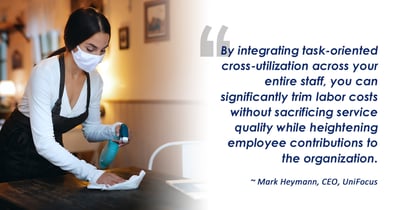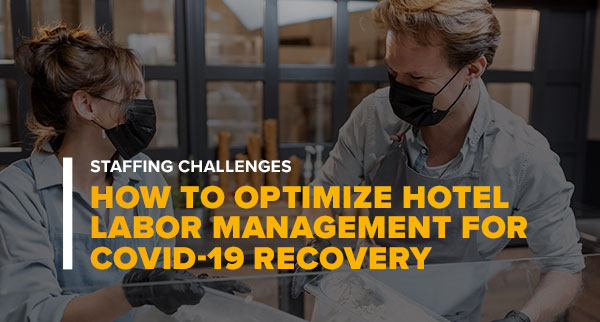July 12, 2020– Published in Hotel Executive – For hotels and restaurants, optimizing labor management processes has an entirely different meaning than it did in in the past. The previous formula revolved around maximizing productivity by ensuring the right number of employees working at the right times to provide high-quality service for your customers. There was significant data to predict business volumes and patterns, which were influenced by business demands, travel and events, seasonality, and location.
We all know that is no longer the case.
Frankly, uncertainty reigns amid the COVID-19 pandemic. The world of hotels and restaurants has become highly unpredictable and will remain that way for at least the next 6 -12 months. There are a series of new challenges – such as high levels of unemployment, lack of consumer confidence in traveling and eating in public settings, ramped up cleanliness requirements, strict occupancy restrictions, rehiring employees at reduced hours, catering to single-parent employees, lack of childcare resources and more. The list goes on.
An adjusted labor management approach will be vital to navigating new industry waters. As this environment is exceedingly tough to predict, more short-term staffing decisions will need to be made to maintain operational efficiency. While optimizing labor previously revolved around external variables, taking internal processes into account will now be of equal importance. Companies will need to foster positive experiences for both customers and employees alike to restore consistent levels of profitability down the road.
Overall, an enhanced focus on optimizing labor management to service levels, employee engagement, flexible scheduling and task-oriented positions will strengthen an organization's ability to make a complex pandemic recovery.
Staffing Related to Service Levels
 Trying to grasp expected guest levels will be especially important during the early stages of the recovery period. Considering demand is the primary determinant for the number of employees needed on a given shift, restaurants and hotels should be more vigilant about monitoring evolving guest volume trends on a day-to-day, week-to-week and month-to-month basis. Peak service times may well change as people look to eat when restaurants are less populated.
Trying to grasp expected guest levels will be especially important during the early stages of the recovery period. Considering demand is the primary determinant for the number of employees needed on a given shift, restaurants and hotels should be more vigilant about monitoring evolving guest volume trends on a day-to-day, week-to-week and month-to-month basis. Peak service times may well change as people look to eat when restaurants are less populated.
There's an added level of uncertainty coming directly from consumer confidence levels. If a restaurant or hotel used to be able to accurately predict the need for 12 employees for a dinner shift, that number may now fluctuate based on unsure demand in the 8-14 range – which will require on-call and call-off scheduling practices. There's a delicate balance involved, because if there are too many/not enough employees on the clock for a specific shift, either profitability or service quality suffers. And with a razor-thin margin for error, there simply isn't room for businesses to miscalculate labor needs.
A network of on-call employees will be required if staffing hours need to be adjusted in real time. Managing staff levels based on volume coupled with customer service demand patterns, rather than shift times, will be another critical component of the recovery. A third key will be cross training staff so when work is completed in one job or task, another assignment will be available to fully utilize paid hours. All are proactive strategies that preserve operational efficiency and profitability.
Creating an Engaged Staff
As I mentioned, catering to employee needs is a vital component to success – perhaps now more than ever. There's a service industry adage as old as time that states, "an engaged staff is a productive staff." Another is "guest satisfaction mirrors employee satisfaction." Both certainly ring true today.
COVID-19 recovery will be dependent upon employee engagement. Your staff will need to have an "all-in" mindset toward flexible scheduling and untraditional labor practices vital to restoring consumer confidence and managing unpredictable availability. Those practices may include servers wearing masks, ramped up hourly sanitation practices, varying shift durations or even covering a co-worker's shift at the last minute. Regardless of what it entails, your employees will be a lot more inclined to buy in if they feel valued. Full staff engagement will be the difference between employees following through with newly mandated tasks such as sanitizing tables in plain sight of the customer.
While I do believe businesses cared about the well-being of their employees before the pandemic, the actual reality is that some restaurants and hotels cared more than others. However, in order to weather the challenges of recovery, showing empathy toward your staff should now be viewed as non-negotiable. After all, everyone's struggling in some form or fashion right now – so we should all be willing to lend a helping hand.
How? For one, making a conscious effort to understand your employee's personal circumstances is a good way to start. People are managing all kinds of external variables due to the pandemic, whether it's taking care of family members, recovering from illness, or maintaining their mental health. Sometimes, those aspects of life take precedence over work. Organizations need to take these factors into account in order to operate effectively.
Balancing Flexible Scheduling
In addition to business demands, employee availability will be highly unpredictable, so restaurants and hotels will need to have scheduling processes in place to address the new dynamic. Until the pandemic subsides, employee availability will fluctuate based on reasons outside of their control. For example, parents who work in the industry will have children home without school or summer camp. As of now, childcare services are limited, and even when they do return, parents may be reluctant to send their kids back due to concerns about social distancing and sanitation capabilities. If that's the case, parent employees may need to adjust their schedules – such as working 12-hour shifts three days a week to make sure their children are accounted for but still earn a livable income. Employees may be dependent not only on their spouses or partners, but also on other team members, therefore requiring different workday scheduling protocols; Employee A watches both sets of kids on Mondays and Wednesdays while Employee B works, and Employee B watches them on Tuesdays and Thursdays while Employee A works. Regardless, restaurants and hotels will need to be open to these untraditional practices to cater to the needs of their employees while ensuring staff coverage.
Since employee availability could very well change on a week-to-week basis, companies should also explore advanced technology labor management solutions. There are automated scheduling systems that allow for optimized control and flexibility, like adjusting shift times and durations, weekly schedules on the fly to streamline availability changes. It simplifies the process of managing an ongoing hectic schedule and keeps everyone on the same page, so management can place more focus on other tasks that impact day-to-day operations.
Shifting to Task-Oriented Labor
 Maximizing the operational efficiency of your staff will require the implementation of cross-utilization so employees can perform numerous positional responsibilities during a single shift. However, that means the roles must transition from a job class-oriented approach to a task-oriented approach. Prioritizing tasks over jobs will afford restaurants and hotels with greater opportunities to cross-utilize. The frequency of performing certain tasks varies with volume. Through task-oriented cross-utilization, companies align with the varying volume levels and enable staff to address needs in other operational areas.
Maximizing the operational efficiency of your staff will require the implementation of cross-utilization so employees can perform numerous positional responsibilities during a single shift. However, that means the roles must transition from a job class-oriented approach to a task-oriented approach. Prioritizing tasks over jobs will afford restaurants and hotels with greater opportunities to cross-utilize. The frequency of performing certain tasks varies with volume. Through task-oriented cross-utilization, companies align with the varying volume levels and enable staff to address needs in other operational areas.
Think of it like a casino where there are blackjack dealers, craps dealers, roulette dealers and poker dealers. All are experts at their specific games. But then there's also a set of multi-skilled dealers who can work multiple tables during a single shift based on need, thus decreasing the casino's labor costs during periods of downtime. Now, apply that to a restaurant. A dishwasher can buss tables when the kitchen isn't backed up. A host can contribute to sanitation requirements by wiping down tables and door handles when there aren't incoming guests to accommodate. So instead of paying four different employees, you're only paying two.
The same goes for hospitality, where adjustments can be made based on guest rates and revenue-per-room. In this case, a front desk attendee would fulfill specific hosting tasks during restaurant peak times. He would work the desk in the morning, and switch to the restaurant for lunch and dinner hours while earning the same wage. Let's say the front desk pays $11 per-hour, while hosts earn $9 per-hour. A four-hour shift would earn the former $44 and the latter $36. However, if you cross-utilize the front desk attendee to host during peak hours, you eliminate the need to pay both employees. Your average wage rate increased by $2, however your total cost for that six-hour decreased by $14.
By integrating task-oriented cross-utilization across your entire staff, you can significantly trim labor costs without sacrificing service quality while heightening employee contributions to the organization.
This winding road to COVID-19 recovery will require innovation and an open mind for rethinking past practices. The truth is, prior "standard" approaches don't apply anymore after COVID-19 flipped the service industry on its head. The entire landscape has changed. Though by optimizing labor management with proactive and innovative strategies, restaurants and hotels can establish the adaptability needed to stay on course amid an ever-evolving industry landscape. And perhaps most critically, return to profitability faster.
Click here to read the original article in Hotel Executive.






